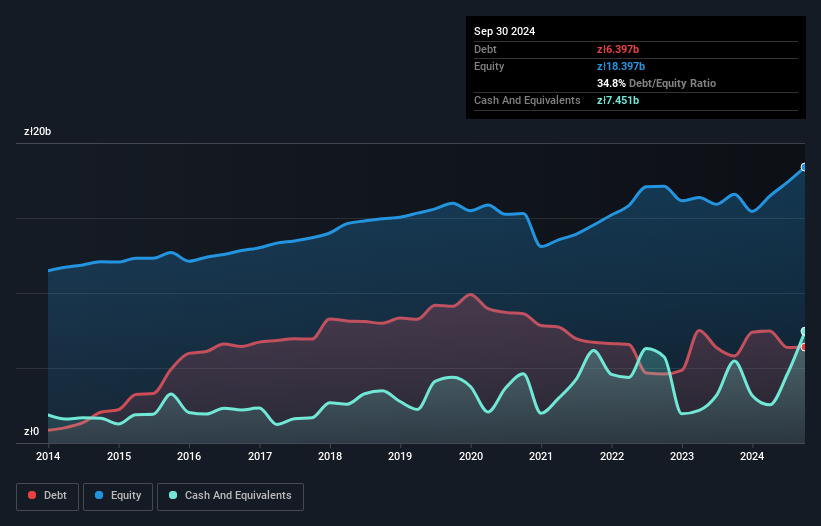David Iben put it well when he said, 'Volatility is not a risk we care about. What we care about is avoiding the permanent loss of capital.' So it might be obvious that you need to consider debt, when you think about how risky any given stock is, because too much debt can sink a company. Importantly, ENEA S.A. (WSE:ENA) does carry debt. But the more important question is: how much risk is that debt creating?
When Is Debt A Problem?
Debt and other liabilities become risky for a business when it cannot easily fulfill those obligations, either with free cash flow or by raising capital at an attractive price. If things get really bad, the lenders can take control of the business. However, a more frequent (but still costly) occurrence is where a company must issue shares at bargain-basement prices, permanently diluting shareholders, just to shore up its balance sheet. Of course, the upside of debt is that it often represents cheap capital, especially when it replaces dilution in a company with the ability to reinvest at high rates of return. The first step when considering a company's debt levels is to consider its cash and debt together.
See our latest analysis for ENEA
What Is ENEA's Net Debt?
The image below, which you can click on for greater detail, shows that at September 2024 ENEA had debt of zł6.40b, up from zł5.81b in one year. However, its balance sheet shows it holds zł7.45b in cash, so it actually has zł1.05b net cash.

How Healthy Is ENEA's Balance Sheet?
According to the last reported balance sheet, ENEA had liabilities of zł10.5b due within 12 months, and liabilities of zł9.53b due beyond 12 months. Offsetting these obligations, it had cash of zł7.45b as well as receivables valued at zł5.87b due within 12 months. So it has liabilities totalling zł6.71b more than its cash and near-term receivables, combined.
When you consider that this deficiency exceeds the company's zł6.33b market capitalization, you might well be inclined to review the balance sheet intently. Hypothetically, extremely heavy dilution would be required if the company were forced to pay down its liabilities by raising capital at the current share price. ENEA boasts net cash, so it's fair to say it does not have a heavy debt load, even if it does have very significant liabilities, in total.
Even more impressive was the fact that ENEA grew its EBIT by 226% over twelve months. If maintained that growth will make the debt even more manageable in the years ahead. When analysing debt levels, the balance sheet is the obvious place to start. But ultimately the future profitability of the business will decide if ENEA can strengthen its balance sheet over time. So if you're focused on the future you can check out this free report showing analyst profit forecasts.
Finally, a company can only pay off debt with cold hard cash, not accounting profits. While ENEA has net cash on its balance sheet, it's still worth taking a look at its ability to convert earnings before interest and tax (EBIT) to free cash flow, to help us understand how quickly it is building (or eroding) that cash balance. In the last three years, ENEA created free cash flow amounting to 18% of its EBIT, an uninspiring performance. That limp level of cash conversion undermines its ability to manage and pay down debt.
Summing Up
While ENEA does have more liabilities than liquid assets, it also has net cash of zł1.05b. And it impressed us with its EBIT growth of 226% over the last year. So we don't have any problem with ENEA's use of debt. When analysing debt levels, the balance sheet is the obvious place to start. But ultimately, every company can contain risks that exist outside of the balance sheet. Case in point: We've spotted 2 warning signs for ENEA you should be aware of, and 1 of them is concerning.
At the end of the day, it's often better to focus on companies that are free from net debt. You can access our special list of such companies (all with a track record of profit growth). It's free.
Valuation is complex, but we're here to simplify it.
Discover if ENEA might be undervalued or overvalued with our detailed analysis, featuring fair value estimates, potential risks, dividends, insider trades, and its financial condition.
Access Free AnalysisHave feedback on this article? Concerned about the content? Get in touch with us directly. Alternatively, email editorial-team (at) simplywallst.com.
This article by Simply Wall St is general in nature. We provide commentary based on historical data and analyst forecasts only using an unbiased methodology and our articles are not intended to be financial advice. It does not constitute a recommendation to buy or sell any stock, and does not take account of your objectives, or your financial situation. We aim to bring you long-term focused analysis driven by fundamental data. Note that our analysis may not factor in the latest price-sensitive company announcements or qualitative material. Simply Wall St has no position in any stocks mentioned.
About WSE:ENA
ENEA
Generates, transmits, distributes, and trades in electricity in Poland.
Flawless balance sheet and fair value.
Similar Companies
Market Insights
Community Narratives



